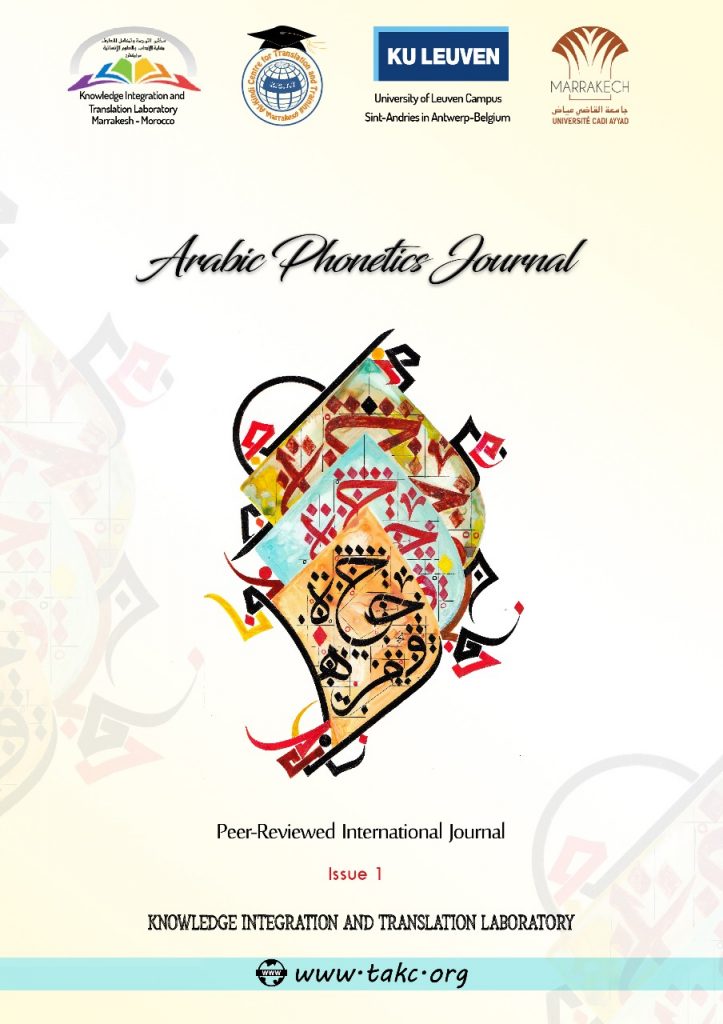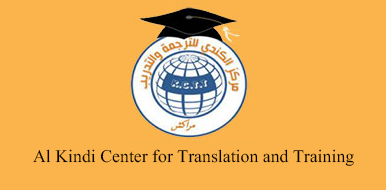
Preamble
There is a remarkable scarcity of both research and published works in the Arab world concerning knowledge about phonetics. This scarcity is noticed at the level of specialized and peer reviewed journals as well as books written on this topic. Within this context, the Knowledge Integration and Translation Laboratory (KIT Lab) (http : takc.org/), Cadi Ayyad University affiliated Translation Research Group based at the Faculty of Letters and Human Sciences, Marrakech-Morocco) in collaboration with Al-Kindy Center for Translation and Training undertook the task of founding a peer reviewed scientific journal, following the example of ‘Tarjamiyaat Journal of Translation Studies,’ to delve into Arabic phonetics and knowledge integration between the scientific study of speech sounds and other sciences together with comparative phonetic studies.
The name chosen for this journal is ‘sawtiyaat l-‘Arabiya’ (Arabic Phonetics). It aims at being a meeting space for specialists in the field both inside and outside the Arab world where there will be an opportunity to research into phonetic and phonological issues of Arabic. It has also the objective to compare Standard Arabic with its dialects and other languages at the phonetic level. Besides, it seeks to explain the phonetic issues and their integration into various fields and cognitive domains.
The scientific approach of ‘Sawtiyaat l-‘Arabiya’ Journal aspires to benefit from the scholarly achievements of modern phonetic laboratories and carefully read the Arabo-Islamic phonetic heritage in such a way as to unravel Muslims’ contributions to phonetic phnomena in its own right and in its interaction with and integration into linguistic and Islamic sciences.
Journal of Arabic Phonetics:
Journal of Arabic Phonetics is an international, scientific, peer reviewed Journal which aims at researching into traditional and modern phonetic studies. The journal is published by the Knowledge Integration and Translation Laboratory and the Department of Arabic and Translation at Louvain University in Belgium in collaboration with Alkindi Center for Translation and Training, under the supervision of a scientific board composed of university researchers from different National and international unversities. These researchers are specialized in phonetic studies and interdisciplines which relate phonetics with various cognitive sciences.
The journal receives research papers and specialized scientific articles in Arabic, English and French together with phonetic studies translated from other languages into Arabic. These scientific contributions should observe and respect the guidelines specified herein.
The Aims of the Journal:
The Journal seeks to reach the following goals :
- To improve research in Phonetics within the Arab World.
- To strengthen the scientific link between researchers and specialists with the aim to boost this scientific field.
- To spread knowledge in the field of phonetic and phonological studies and all that relates to them and integrates with them in order to generalise this knowledge in the Arab world in a way which will benefit the Arabic language and enrich the Arabic library.
- To show the limit of cognitive integration between phonetics and various cognitive fields such as grammar, rhetoric, philosophy, music and others.
- To display the contributions of ancient Arabs to the foundation and development of phonetics.
- To rewrite the Arabic phonetic heritage with the aim to benefit from the findings and results of Modern phonetics.
- To encourage rigorous scientific work and introduce efforts of Arab scholars in the field of phonetic studies.
- To create a space allowing the possibility for an exchange of information between specialized scholars in phonetics and phonology.
- To offer researchers the opportunity to publish their credible scientific contributions in phonetics and phonology within this academic space.
- To introduce scientific projects in both fields.
- To compile a Lexicon of phonetics and phonology in Arabic.
The axes of the Journal:
Articulatory phonetics
Acoustic phonetics
Auditory phonetics
Comparative phonetic studies between Arabic and other languages
The phonetics of Arabic dialects and its relation with Standard Arabic
Phonetics in the Arabo-Islamic heritage
Phonetics in the view of philosophers and the Sufis (Muslim mystics)
Phonetics and rhetoric
Phonetics and the science of music
Phonetics and lexicography
Phonetics and the science of Quran recitation
Phonetics and the science of the readings of Quran
Phonetics and exegesis
Comparative phonetics and phonology
Phonostylistics
Main Rubrics:
- From the edidor
- Research Articles : This rubric includes issues relating to the Arab language or comparing the latter with other languages. This rubric also includes studies in ancient and modern phonetics and phonology.
- Translated texts : This rubric includes phonetic and phonological studies on Arabic. The articles written in other languages are translated into Arabic.
- Recent Publications : This rubric is dedicated to an introduction of brief accounts on recently published works in both phonetics and phonology written in Arabic or any other language. The rubric also offers reports on various scientific conferences and round tables related to phonetics and phonology.
- Interviews : This rubric invites leading figures in phonetics and phonology .
The Journal Procedures:
- The papers are subject to the criteria and conditions of secret and blind peer reviewing followed by academic and scholarly research carried out by a scientific committee of the Journal.
- The contributor is electronically notified of both the reception of his/her paper and the acceptance of publication of his/her work after having gone through peer reviewing.
- Following the reviewers’ suggestions, papers that need amendments will be sent back to their authors to introduce the necessary changes in them before being published.
- The Journal abides by strict scientific and ethical standards, and authors take sole responsibility for their views.
- The journal reserves the right to publish or not the papers and is in no way accountable for the refusal of others.
- The submission file should be in Microsoft Word File Format and should be submitted electronically as e-mail attachments.
Paper submission guidelines and requirements:
Authors are required to check their submissions’ compliance with all the following guidelines. Submissions that do not abide by these guidelines may not be published.
-The paper should be revised, corrected, and free from grammatical, spelling and printing mistakes.
-The contributions submitted to the journal must contain original works not having been previously published or are under consideration by another journal (including electronic publication).
– The papers should observe scientific rigour and must be related to the axes of the journal.
– The contributions should adhere to the principles of scientific research and the established requirements of scholarly writing ; they should also abide by the guidelines governing references, tables, figures, etc.
– The paper should include:
1- A cover page with the full title of the paper, the author’s full name, his affiliation, his e-mail address, and phone number.
2- An abstract of about 200 words in English translated into Arabic.
3- Key words of the whole paper should figure at the end of the abstract.
4- The author should join his CV with his paper.
- The number of pages of the paper will vary from 15 to 20 with one inch margin on all sides, using double line spacing and a 12 point, Times New Roman Font.
- All Primary titles should be written in 18 point and the secondary ones in 16 point.
- All references are ordered alphabetically at the end of the paper including the name of the author, the year of publication, the title of the book, house and place of publication.
- Footnotes should be avoided. In case there is need to them, the author is required to place them at the end of the paper before the references section.
- All references and citations must be in APA format.
The papers will be sent to ‘Journal of Arabic Phonetics’ at the following e-mail address :
arabicphoneticsjournal@gmail.com
Editorial Board:
Editor-in-Chief:
| § Abdelhamid Zahid – Maroc
|
Associate Editors:
| § Abied Alsulaiman – Belgique |
| § Abdelkader Marrah – Maroc |
| § Noreddine Hanini – Maroc |
Editorial board members: (in first name alphabetical order):
| § Hassane Darir – Maroc | § Abdelaziz Ait Baha – Maroc |
| § Houda Raoud – Maroc | § Abdelfettah Ibrahim – Tunisie |
| § Jamaa Ouchouid – Maroc | § Abdelmonaîm Harfane – Maroc |
| § Mebarek Blali – Algérie | § Abdelouahed Lamrabet – Maroc |
| § Mohamed Alaoui – Maroc | § Abderrahmane Maâchi – Algérie |
| § Mohamed Amine – Maroc | § Aboubakr Hassini -Algérie |
| § Mohamed Fathi – Maroc | § Adel Mehellou – Algérie |
| § Moatassim El Kartouti – Maroc | § Ahmed Albaibi – Maroc |
| § Nedra Ben Slama – Tunisie | § Ahmed Kerroum – Maroc |
| § Noureddine Azmi – Maroc | § Brahim Assikar– Maroc |
| § Rachid Aaradi – Maroc | § Fatma Trassim – Maroc
|
| § Youssef Oudraoua – Maroc | § Hanane Moudari – Maroc |
Advisory Board: (in first name alphabetical order):
| § Mehdi Bourouba – Algérie | § Ahmed Alioua – Maroc |
| § Mohammed Taki – Maroc | § Christian Guilbault –Canada |
| § Moulay Mohamed Khabir – Maroc | § Ghanim Alhamad – Irak |
| § Mourad Mawhoub – Maroc | § Hassan Nejmi – Maroc |
| § Rachid Hamdi – Maroc | § Ibtisam Hussein Jamil Mohammad – Jordanie |
| § Salem Ghazali – Tunisie | § Mbraek Hanoun – Maroc |
| § Zayd Khaleel Falah Alqaralleh – Jordanie | |
- Technical Committee (in first name alphabetical order)
| § Mohamed Ouasseksou | § Abdelaziz Tizguini |
| § Said Katfi | § Baj Bakkar |

